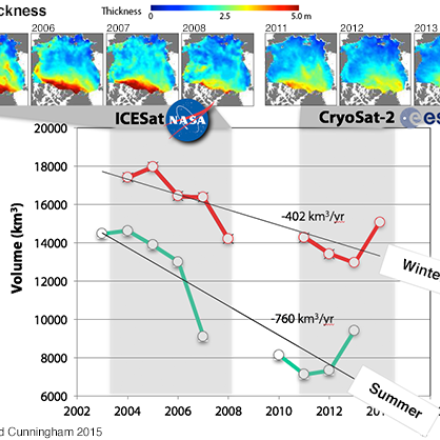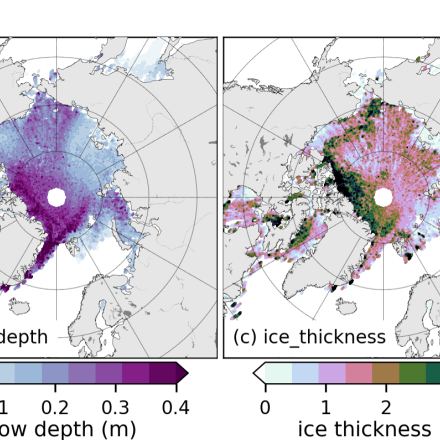|
Sea ice freeboard, snow depth and thickness from Envisat, CryoSat-2 and CryoSat-2/Saral fusion
|
AVISO/Center for Topographic studies of the Ocean and Hydrosphere |
Antarctic, Arctic |
2002/03 to present |
Monthly |
25 km |
netCDF |
Envisat, CryoSat-2 and CryoSat-2/Saral fusion |
|
Along-track sea ice freeboard from ICESat-2
|
NSIDC |
Antarctic, Arctic |
2018/10 to present |
Sub-daily |
Variable along-track (typically ~30-75 m) |
HDF5 |
ICESat-2 |
|
Along-track, quick look sea ice freeboard from ICESat-2
|
NSIDC |
Antarctic, Arctic |
2023/01 to present |
Sub-daily |
Variable along-track (typically ~30-75 m) |
HDF5 |
ICESat-2 |
|
Gridded sea ice freeboard from ICESat-2
|
NSIDC |
Antarctic, Arctic |
2018/10 to present |
Daily, Monthly |
25 km |
HDF5 |
ICESat-2 |
|
Unified Sea Ice Thickness Climate Data Record
|
NSIDC/Axel Schweiger and others |
Antarctic, Arctic |
1947/01 to present |
Daily, Weekly, Monthly |
50 km |
ascii |
aircraft, satellites, moorings |
|
Sea Ice Thickness Data from Gridded Products
|
NSIDC |
Arctic |
1993/01 to 2014/12 |
Monthly |
100 km |
netCDF |
ULS, airborne laser, and radar altimetry |
|
Sea Ice Freeboard and Thickness from ICESat (G)
|
NSIDC/Donghui Yi, H. Zwally |
Arctic |
2003/02/20 to 2008/10/19 |
Campaigns, Daily |
70 m |
ascii |
GGLAS, SSM/I, snow climatology |
Sea Ice Freeboard, Thickness and Snow Depth from IceBridge
|
NSIDC/Nathan Kurtz and others |
Antarctic, Arctic |
2009/03/19 to 2013/04/25 |
Varies |
varies |
ascii |
Airborne altimetry |
|
Near Real-time (NRT) Sea Ice Thickness (and archive) from CryoSat-2
|
ESA, processed at the NERC Center for Polar Observation and Modelling (CPOM), UCL |
Arctic |
2010/10 to present |
2 Days, 14 Days, 28 Days |
5 km |
netCDF, ascii, GeoTIFF |
CryoSat-2 |
|
Sea Ice Thickness from AWI-CryosSat-2
|
Alfred Wegener Institute, Helmholtz Centre for Polar and Marine Research |
Arctic |
2010/11 to present |
Monthly |
25 km |
netCDF |
CryoSat-2 |
|
Daily Thickness of Thin Sea Ice from SMOS
|
Alfred Wegener Institute, Helmholtz Centre for Polar and Marine Research, University of Hamburg |
Antarctic, Arctic |
2010/10 to present |
Daily |
12.5 km |
netCDF |
SMOS |
|
Weekly Sea Ice Thickness from CryoSat2/SMOS Data Fusion
|
Alfred Wegener Institute, Helmholtz Centre for Polar and Marine Research, University of Hamburg |
Antarctic, Arctic |
2010/11/15 to present |
Weekly |
25 km |
netCDF |
CS2-SMOS Data Merging |
|
Simulated Sea Ice Thickness from the Pan-Arctic Ice Ocean Modeleing and Assimilation System (PIOMAS)
|
Polar Science Center at the University of Washing- ton/Jinlun Zhang |
Arctic |
1979/01 to present |
Daily, Monthly |
mean 22 km |
binary |
coupled Parallel Ocean and Sea Ice model and assimilation |
|
Simulated Sea Ice Thickness from the Global Ice-Ocean Modeleing and Assimilation System (GIOMAS)
|
Polar Science Center at the University of Washing- ton/Jinlun Zhang |
Global |
1979/01 to present |
Monthly |
mean 22 km |
binary |
coupled Parallel Ocean and Sea Ice model and assimilation |



